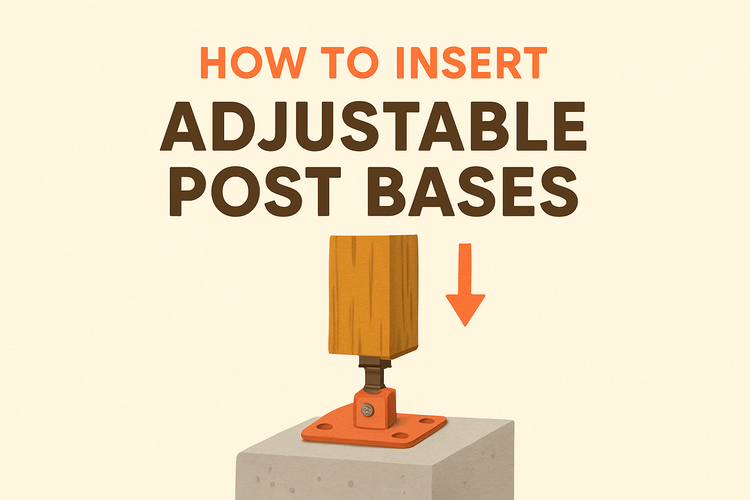How To Insert Adjustable Post Bases

Preparing the Site for Adjustable Post Bases
Before installing adjustable post bases, it's essential to begin with a clean, level surface. This lays the foundation for structural stability and ensures your post bases are applied correctly.
Start by marking out the exact locations where each post will be installed. Clear any debris or vegetation, and ensure the ground or concrete base is flat and properly compacted. A solid foundation is key to preventing shifting and movement over time. For timber construction, using post bases can further support structural integrity. These bases are specifically designed to anchor posts firmly while allowing height adjustments during or after installation.
If you plan to anchor to concrete, drill appropriate holes for anchor bolts using a masonry bit. Precise alignment is important. Ensure that measurement lines are square to one another because the post alignment will conform to these guide lines.
Installing the Post Base Anchors
With the location prepared, the next step is to secure the adjustable post bases to the foundation material, whether concrete, masonry, or wood.
For concrete surfaces, use concrete anchors or bolts to fix the base. Begin by setting the base in the outlined position and mark the hole locations. Drill using the recommended bit size for the anchor type. Clean the holes thoroughly before inserting anchors, then fasten the post base using socket wrenches. Using high-quality screws and nails ensures secure anchoring and compatibility with treated timber or metal bases.
Wooden bases require lag bolts or structural screws. Pre-drill to avoid splitting and ensure a snug fit. The adjustable post base allows for minor adjustments in height or angle, which is critical when leveling across uneven surfaces. Some contractors prefer to allow a minor elevation above ground level using shims or washers to avoid moisture contact.
When dealing with high-load structures or in zones susceptible to heavy winds, it's advisable to use hardware from the high wind ties & timber connectors category to enhance stability and resistance.
Aligning and Attaching Timber Posts
Once the bases are installed, aligning your timber posts accurately is key to maintaining the strength and appearance of the structure.
Carefully lower each timber post into the socket or saddle of the adjustable base. Use a level to check both vertical and horizontal alignment. It’s always better to check plumb as you go rather than correcting later. Make use of clamps or temporary bracing to hold each post in place.
Once aligned, drill pilot holes through the base holes into the timber and secure with lag bolts or structural screws. Depending on your timber type and load requirements, choose fasteners compatible with treated wood. Adjustable bases offer the flexibility to fine-tune the post elevation even after securing, which is especially helpful for decks, pergolas, or porches that may need to account for slight terrain variations.
Ensuring Structural Integrity with Compatible Connectors
Securing your timber posts isn’t just about the base. Supporting components like beams and braces must be attached with compatible connectors to ensure an overall stable frame.
Using components such as angle brackets and joist hangers is essential to tie the full structure together. For example, joist hangers can be employed to carry lateral load-bearing members connected to the posts. They provide strong support and reduce the risk of sagging over time. Similarly, angle brackets can be used to add diagonal bracing, which prevents racking and enhances rigidity of connections.
By integrating these connectors with your post base setup, you create a network of support that reinforces each element. Also, these links allow your build to expand in complexity. For example, if you decide to add a cross beam or truss later, you're already structurally prepared.
Maintenance and Long-Term Considerations
After installation, adjustable post bases require minimal maintenance, but regular checks can extend the life and safety of your structure.
Inspect the post base connection points annually or after severe weather. Look for signs of corrosion on metal surfaces and check for any timber shrinkage that might have loosened fasteners. Tighten hardware if necessary and keep timber sealed or painted to limit moisture ingress.
If your structure is exposed to coastal or highly humid environments, consider using stainless steel variants or those with high-grade anti-corrosion coatings. By pairing well-maintained post bases with other durable hardware—like angle brackets or restraint straps—you ensure every part of your timber frame remains reliable over years of use.
